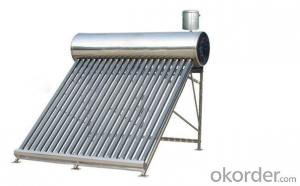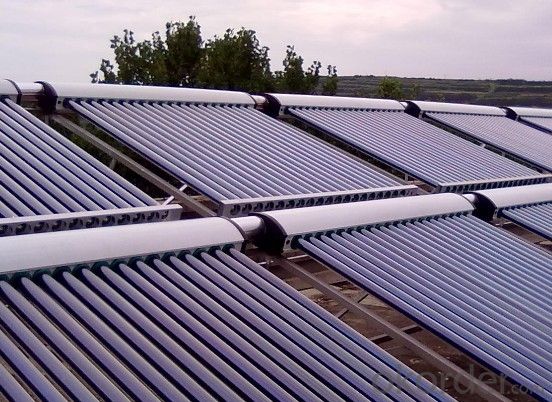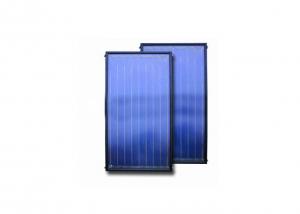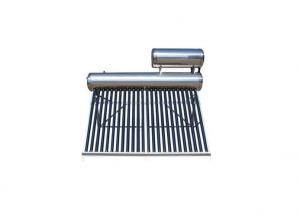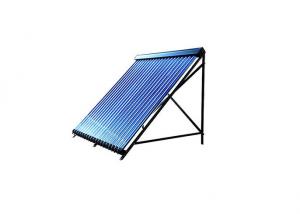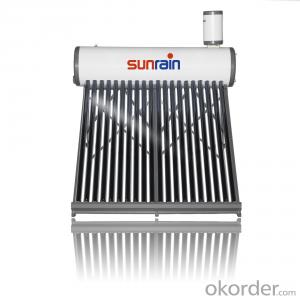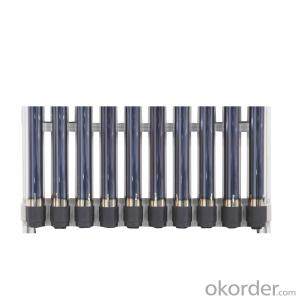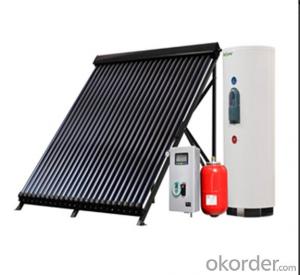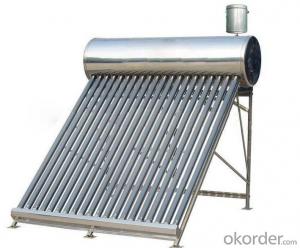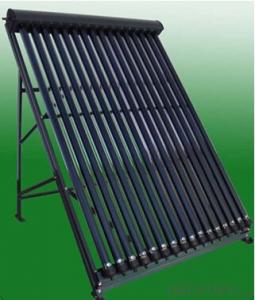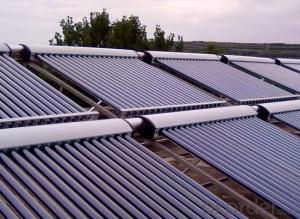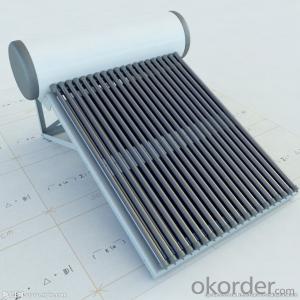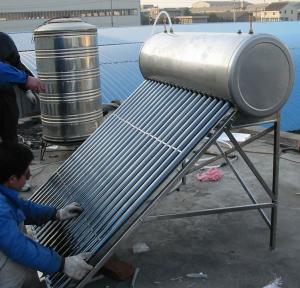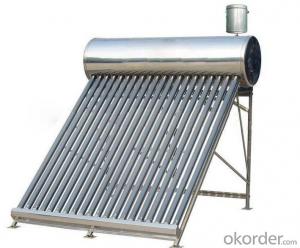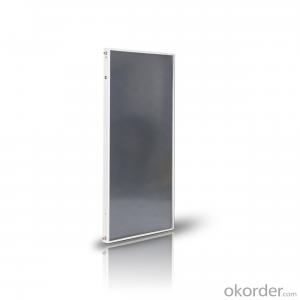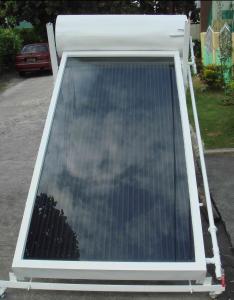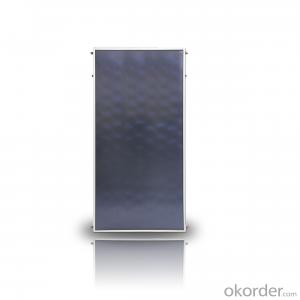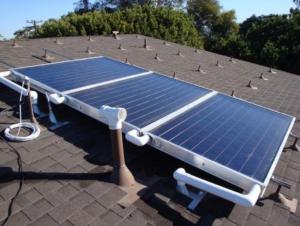Tankless Solar Water Heater - Color Steel Compact Pressure Solar Heater
- Loading Port:
- China main port
- Payment Terms:
- TT OR LC
- Min Order Qty:
- 1 set
- Supply Capability:
- 6000 set/month
OKorder Service Pledge
OKorder Financial Service
You Might Also Like
Introduction of Non-Pressure Solar Water Heater:
Non-pressure Solar Heater is one of the most economical solar water heating device with pretty high efficiency at the same time. It consists of hot water storage tank, solar vacuum tubes with mouth plug in storage tank, and bracket supporting tank and tubes.When cold water in evacuated tubes is heated with solar irradiation, as the specific gravities of hot water and cold water are different, hotter water goes upward to storage tank and colder water goes downward to glass tubes. through this continuous circulation, the cold water in storage tank will be gradually heated till sunset.
Specialty:
1. High thermal performance and working temperature: the heat exchanging rate even in winter can up above 55%.
2. Heat collecting efficiency is at least 20% above common solar systems.
3. Work in all day and all season: no matter any corner of the world, this system can work well even -40℃ to avoid the tube freezing problem.
4. Reliability: No water following through the tube, so water scale can not generate and tube cracks could be avoided, the system still can keep working even with some damaged tubes.
5. It can connect with water tap and work automatically with pressure0.6Mpa, bring enjoyable washing experience.
6. Safety: P/T valve would release pressure and temperature to protect tank..
Technical Specification:
1. Outer tank material: SUS304 stainless steel or powder coated color steel
2. Inner tank material: 1.2mm thick SUS304 food grade stainless steel ( Optional material SUS316L)
3. Vacuum tube material: borosilicate glass 3.3; AL-SS-CU absorb coating, with copper heat pipe inside
4. Frame material: 1.2mm thickness stainless steel
5. Insulation material: 55mm thickness polyurethane
6. Suitable for mains pressure water(up to 8 bar/116psi)
7. Easy plug-in installation
8. Install the T/P valve on the pressurized tank
9. Seal material: Stabilized High Temperature Silicon
Outer tank material: SUS304 stainless steel or powder coated color steel
Inner tank material: 1.2mm thick SUS304 food grade stainless steel ( Optional material SUS316L)
Vacuum tube material: borosilicate glass 3.3; AL-SS-CU absorb coating, with copper heat pipe inside
Frame material: 1.2mm thickness stainless steel
Insulation material: 55mm thickness polyurethane
Suitable for mains pressure water(up to 8 bar/116psi)
Easy plug-in installation
Install the T/P valve on the pressurized tank
Seal material: Stabilized High Temperature Silicon
19. Vacuum Tube | 20. Size (mm) | 21. Φ47*1500 / Φ58*1800 / Φ70*2100 | |||||
22. Tube (pcs) | 23. 10 / 12 / 15 / 18 / 20 / 22 / 24 / 30 / 36 / 42 | ||||||
24. Material | 25. Borosilicate 3.3 glass, magnetron spluttering selective coating | ||||||
26. Coating | 27. Single-target AL-N/AL or Three-target AL/N-Cu-SS | ||||||
28. Water Tank | 29. Capacity | 30. 80L ~ 500L for hot water storage tank | |||||
31. Inner tank | 32. Food-grade stainless steel SUS304-2B / SUS316 | ||||||
33. Insulation | 34. High-density polyurethane foam with 70~80 hour heat preservation | ||||||
35. Tank shell | 36. Food-grade stainless steel SUS304-2B | ||||||
37. Bracket | 38. Shaped strong aluminum alloy structure adaptable for flat or slope roof | ||||||
39. Accessories | 40. Anti-aging silicon seals, Dustproof seals, Air-vent cap, Stainless screws | ||||||
41. Auxiliary Devices | 42. Assistant tank, Intelligent controller, Electrical heater, Magnesium anodes | ||||||
43. Tilt Angle | 44. 25 ~ 50° | ||||||
45. Water Output | 46. 45 - 95°C | ||||||
47. Hail Resistance | 48. Φ25mm diameter | ||||||
49. Model Number | 50. Solar Vacuum Tube | 51. Tank 52. Liter | 53. System 54. Liter | 55. Container Loading Qty /sets | |||
56. Size /mm | 57. Qty /pcs | 58. 20GP | 59. 40GP | 60. 40HQ | |||
61. VNS-58SA12-100 | 62. Φ58*1800 | 63. 12 | 64. 100 | 65. 132 | 66. 58 | 67. 119 | 68. 140 |
69. VNS-58SA15-130 | 70. 15 | 71. 130 | 72. 170 | 73. 54 | 74. 108 | 75. 131 | |
76. VNS-58SA18-150 | 77. 18 | 78. 150 | 79. 198 | 80. 43 | 81. 86 | 82. 105 | |
83. VNS-58SA20-170 | 84. 20 | 85. 170 | 86. 223 | 87. 40 | 88. 80 | 89. 97 | |
VNS-58SA24-200 | 24 | 200 | 263 | 35 | 70 | 85 | |
VNS-58SA30-250 | 30 | 250 | 329 | 28 | 56 | 68 | |
VNS-58SA36-300 | 36 | 300 | 395 | 23 | 47 | 57 | |
Products Show
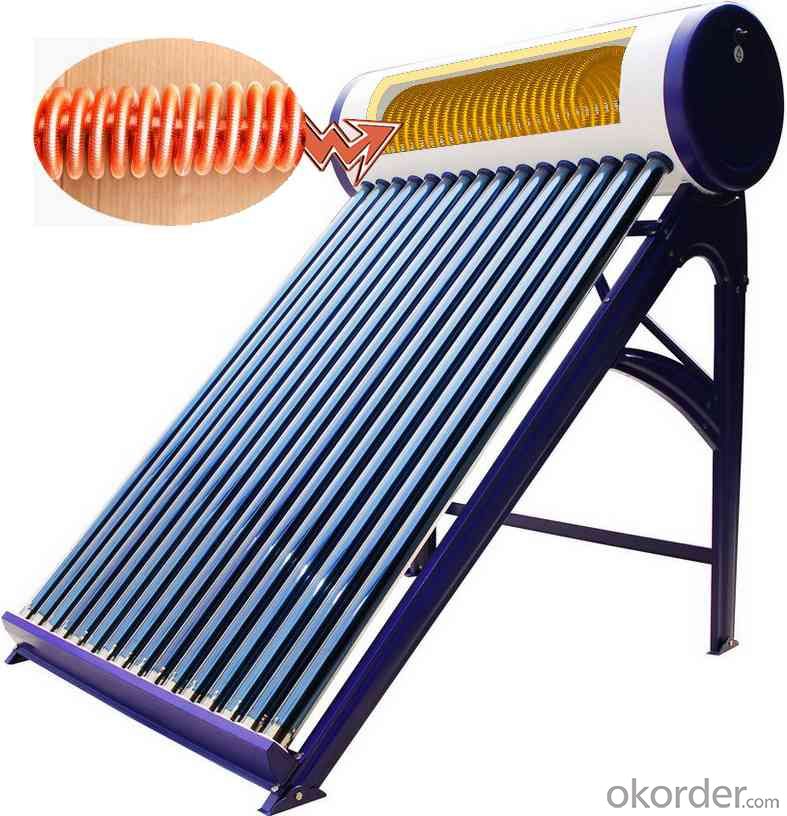
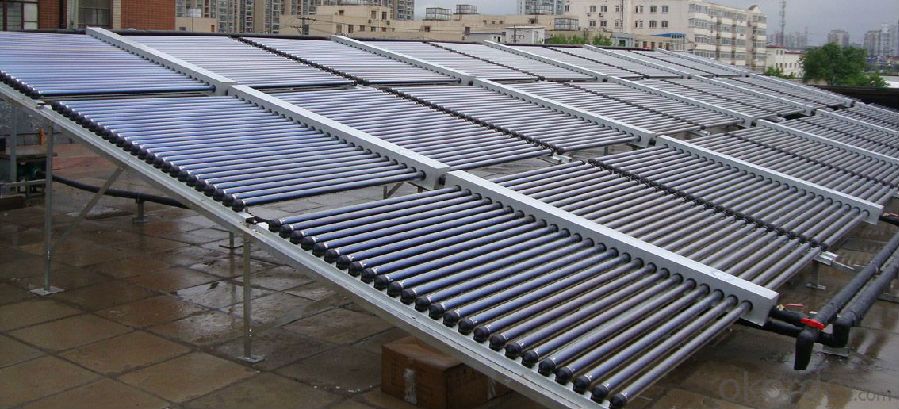
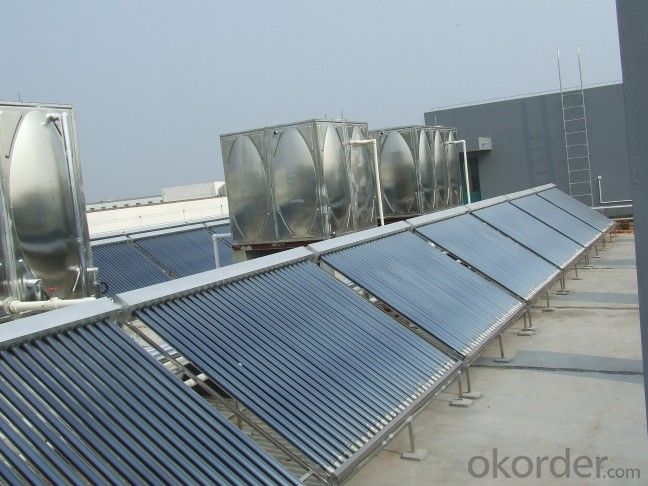
Our Services
1. OEM service
2. Warranty: 5 years
3. Considerable after sale service
Color steel Compact pressure Thermal solar heater
FAQ:
1. What’s the delivery time?
10 days after receiving deposit.
2. How long is the warranty?
5 years for whole system, 1 year for accessory
3. What’s your production capacity?
6000sets/month
4. What’s the MOQ?
1 set.
5. What’s your payment term?
Container: 30% T/T in advance for deposit, 70% T/T before shipment for fist order.
70% T/T after seeing copy of B/L from second order
Sample: 100% T/T in advance
Other choices: L/C at sight.
6. What certifications do you have?
CE, SOLAR KEYMARK, SRCC and etc.
- Q: How does the efficiency of a solar water heater change over time?
- The efficiency of a solar water heater tends to decrease over time due to factors such as wear and tear, degradation of components, and accumulation of dust or debris on the solar panels. Regular maintenance and cleaning can help mitigate this decline, but overall, it is common for the efficiency to gradually decrease as the system ages.
- Q: Can a solar water heater be used in areas prone to hurricanes or tornadoes?
- Yes, a solar water heater can be used in areas prone to hurricanes or tornadoes. However, it is important to secure and protect the system properly to minimize potential damage during severe weather events. Reinforced mounting structures, anchoring, and appropriate precautions can help ensure the safety and functionality of the solar water heater in such areas.
- Q: Can a solar water heater be used in areas with limited roof space?
- Yes, a solar water heater can be used in areas with limited roof space. There are compact and space-saving models available that can be installed in small or unconventional spaces, such as balconies or walls. Additionally, some solar water heaters allow for flexible positioning of the solar panels, allowing them to be installed at an optimal angle even in areas with limited roof space.
- Q: How does a solar water heater perform in areas with high salt content in water?
- A solar water heater may face challenges in areas with high salt content in water. The salt can potentially corrode the system's components and reduce its efficiency. Regular maintenance and proper cleaning of the solar water heater are essential to prevent salt buildup and ensure optimal performance in such areas.
- Q: Can a solar water heater be used in areas with limited access to backup heating systems?
- Yes, a solar water heater can be used in areas with limited access to backup heating systems. Solar water heaters are designed to harness the energy from the sun to heat water, making them an excellent option for areas with abundant sunlight. They do not rely on external backup heating systems, such as gas or electricity, and can provide hot water even in remote locations or areas with limited access to utilities.
- Q: Are there any safety concerns associated with using a solar water heater?
- Yes, there are a few safety concerns associated with using a solar water heater. One of the main concerns is the risk of overheating, especially if the system does not have proper controls or safety features. This can lead to scalding hot water and potential burns. Additionally, there is a possibility of freezing during extremely cold temperatures, which can damage the system if not adequately protected. It is also important to ensure proper installation and maintenance to minimize any safety risks.
- Q: Can a solar water heater be used in areas with limited access to unobstructed sunlight?
- A solar water heater may not be as effective in areas with limited access to unobstructed sunlight. The performance of a solar water heater heavily relies on sunlight exposure to generate heat. In areas with limited access to direct sunlight, the efficiency of a solar water heater may be compromised, resulting in less effective heating of water.
- Q: How does the installation time of a solar water heater compare to a traditional water heating system?
- The installation time of a solar water heater is generally longer than that of a traditional water heating system. This is because a solar water heater requires additional components such as solar panels, a storage tank, and a controller, which need to be properly installed and connected. Additionally, the positioning of the solar panels and the integration with the existing plumbing system may require more time and expertise. However, despite the longer installation time, a solar water heater offers long-term cost savings and environmental benefits, making it a worthwhile investment.
- Q: What is the required maintenance cost for a solar water heater per year on average?
- The required maintenance cost for a solar water heater per year on average is generally low, ranging from $0 to $150. However, this can vary depending on the specific model, age, and condition of the system. Regular inspections and routine maintenance, such as cleaning the panels and checking for any leaks or malfunctions, are recommended to ensure optimal performance and extend the lifespan of the solar water heater.
- Q: Can a solar water heater be used in areas with limited access to environmental impact assessments?
- Yes, a solar water heater can be used in areas with limited access to environmental impact assessments. Solar water heaters have a relatively low environmental impact compared to other types of water heating systems, as they utilize renewable energy from the sun. Therefore, in areas where access to thorough environmental assessments is limited, solar water heaters can be a viable and sustainable option for water heating without significant negative impacts on the environment.
Send your message to us
Tankless Solar Water Heater - Color Steel Compact Pressure Solar Heater
- Loading Port:
- China main port
- Payment Terms:
- TT OR LC
- Min Order Qty:
- 1 set
- Supply Capability:
- 6000 set/month
OKorder Service Pledge
OKorder Financial Service
Similar products
Hot products
Hot Searches
Related keywords
